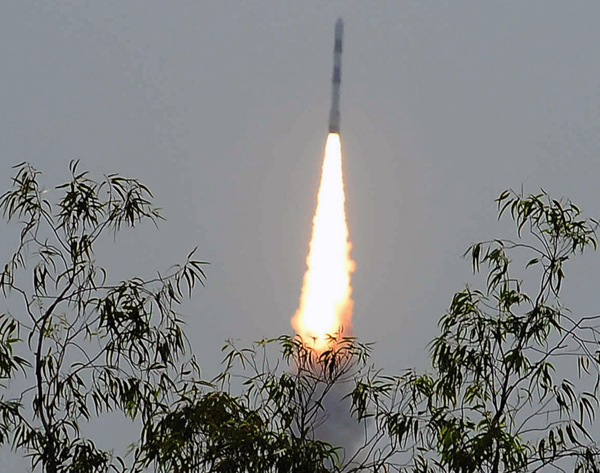|
This is the first time that a Polar Satellite Launch Vehicle (PSLV), the workhorse indigenous rocket of the
Indian Space Research Organisation (ISRO), carried only foreign satellites, taking their tally to 40 since it
launched the first foreign satellite in 1999. India ’s space programme began in 1975, and except for heavy
satellites, for which ISRO depends upon the European Ariane, India uses its own propulsion systems. So far,
India has launched about 100 missions with satellites.
India is yet to perfect the cryogenic technology required for launching heave payloads into space but there
is some success with the Geosynchronous Satellite Launch Vehicle (GSLV) programme whose Mark III version is under
development.
India’s new Prime Minister Narendra Modi was at hand to witness the launch. Apparently inspired, he described
the mission success as "global endorsement of India 's space capability" adding that it made every Indian proud.

Mr Modi, who has initiated a campaign right from his swearing-in ceremony in May 2014 for good relations with
neighbouring countries, offered to build a SAARC Satellite to benefit them. "Today, I ask our space community to
take up the challenge of developing a SAARC satellite - that we can dedicate to our neighbourhood as a gift from
India." This, he said, should have “a full range of applications and services” including for satellite-based
navigation system. The footprint of the satellite should be appropriately enhanced.
Notably, Mr Modi has been pushing for reforms with Skill, Scale and Speed as his government’s mantras. He used
the occasion to reiterate his emphasis on technology for the good of the common man. "I believe technology is
fundamentally connected to common man. It can transform his life."
The main satellite on board the 44.4-meter tall
PSLV-C23 rocket was the 714-kg SPOT 7 (Earth Observation
Satellite) of Airbus Defence and Space. Equipped
with high resolution imaging cameras and sensors,
this satellite has been placed diametrically opposite
to its earlier twin, SPOT-6. That was also launched
from here on 9 September 2012.
The other four satellites belonged to Germany,
Singapore and Canada (two).
ISRO Chairman Dr K Radhakrishnan described the
launch as “high precision” pointing
out that although an error margin of 20 km at
the designated altitude of 655 could be exercised,
it was limited to only seven km.
He disclosed that over the next two years, five
countries including Germany, Britain and Singapore
had tasked India to launch their satellites, and
three of these would be big.
ISRO has an international marketing arm, Antrix.
Its Chairman cum Managing Director VS Hegde indicated
that its business was increasing and Antrix expected
a higher revenue by about 15 per cent in the coming
2015-16 fiscal.
The first satellite to be ejected from the PSLV
in the June 30 launch was SPOT-7. After that,
German AISAT, Canadian NLS7.1 and NLS7.2 and Singapore’s
VELOX-1 were placed in the orbit.
Airbus, which had a team at the space station
to coordinate and monitor the launch, said that
SPOT-7was being placed in a 655-km sun synchronous
orbit.
India began its space programme in 1975 with
very modest beginnings and the scientists of those
days even carried components on bicycles. There
was assistance from the United States initially,
and then from the erstwhile Soviet Union which
also facilitated the first space journey of an
Indian, Squadron Leader Rakesh Sharma of the Indian
Air Force (IAF), in April 1984.
Sq Ldr Sharma received extensive training at
IAF’s test pilots school, Aircraft Systems and
Testing Establishment (ASTE) before being sent
to Baikonur cosmodrome for the launch. He spent
nearly eight days in the Salyut-7 space station
along with two Soviet cosmonauts.
ISRO has sent missions to the mars and moon,
found evidence of water with the help of a Raytheon
radar on the moon, and is now preparing for a
manned mission there. There are many challenges
towards a human flight, requiring capability in
long range propulsion, onboard controls, connectivity
and survival systems. India's Mars Orbiter, launched
on 5 November 2013, has already done about more
than 500 km of its planned 680 km journey, and
is due to rendezvous with the planet on –
or around – 24 September 2014.
India is yet to finalise its programme for human
space flights though. The US Boeing, which has
been the main integrater for Space Shuttle and
NASA's future space programmes, has offered some
assistance. Details are yet to be worked out.
For propulsion, Russia had given half a dozen
cryogenic motors which have all been used up.
The new Government is likely to give the space
programme a firm direction in the coming months.
|